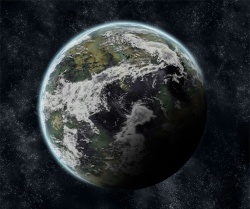
|
| Judecca
|
|
Mid Rim
|
|
Hutt Space
|
|
Cocytus System
|
|
|
|
27 hours
|
|
344 days
|
|
12,470.46 kilometres
|
|
Breathable (elevated oxygen levels)
|
|
Temperate zones over much of the planet, Polar Regions decidedly colder, ice caps form annually, frequent rainfall.
|
|
1.365 Standard
|
|
Mixed, jungle and forest prevalent in equatorial region, rough mountainous areas towards the tropic lines. Small annual Polar Regions.
|
|
The Black Road, Twin Towers, Dragon’s Point, Ghostly Citadel, Lake of Shadows, Black Jungles, The Lonely Moors, Meditation Shrine, Abandoned Temple, Imperial Palace
|
|
Nomadic Refugees, Syrei
|
|
Species of the Dark Brotherhood
|
|
Basic
|
|
57.4 million total, +/- 3 million Nomadic Refugees
|
|
Ohmen (Capital), Teyr, Lyon, Tailyon, Rousae, Missing City
|
|
|
- Education
- Archaic Artefacts
- Exotics
|
|
Clan Scholae Palatinae
|
Judecca is the home planet of Clan Scholae Palatinae, residing in the Cocytus System.
History
The star Imperius, compared to similar Mid-Core astronomical developments, is a relatively new addition to the ring in which is exists. The star’s birth is speculated to have been at the exact moment of the decay of a bi-solar star, creating a series of chain reactions that were highly volatile and birthed the new, white star and its collection of orbiting masses. Not each of these masses formed into a solid entity; however, the first cluster formed and developed into a temperate world of mixed geography: Judecca.
The system, and planets, would slowly evolve, but at the disadvantage of being countless generations behind in technological advancement and expansionary development. The people, whom called themselves the Syrei, were a culture fascinated with mysticism and polytheism. Their natural state of progression advanced to what historians would describe as medieval, or Dark Ages, in the state of both government and technology. A vast amount of emphasis was based on the dealings of the Gods in the actions of mortal men and under the zeal of false gods vast empires quickly rose - or were torn down - with the waxing and waning of warlords.
And the planet remained looped in this volatile stasis until an emissary of the Brotherhood - whom had recently led an exodus from the Outer Rim - came upon the white star and its most bountiful planet of Imperius One. The individual was the appointed Consul of Clan Scholae Palatinae, Cuchulain Darkblade Palpatine, whom was under the direct orders of then Grand Master Firefox to seek out a new dominion for the renewed Dark Brotherhood. Nefariously, he determined the lands that were full of strife would suffice in the Clan’s gain and reminded him of an uncanny recant of the depths of hell by an unknown prophet. The prophet had deemed hell as Cocytus, broken into four levels: Judecca, Antenora, Caina and Ptolomea.
And, thus, the Cocytus system was named by its future rulers and lords: Clan Scholae Palatinae.
As members of the Clan were placed upon the planet their uncanny ability with the Force was interpreted as the highest form of wizardry. As the collective, united mass of the Clan collected lands and brought the warring nations to heel, the Syrie praised them. The masses appointed the Consul as their Emperor - the ruler of their nations - and dubbed those of his court, those of Scholae Palatinae, as those of the Royal Clan and bequeathed untold riches to them for exchange of the technology that would bring the system into unimaginable wealth and advancement.
The planet retained its medieval atmosphere, infusing its Dark Arts and mysticism into the new technology and bringing forth the Golden Age of the Cocytus System under the reign of the planet’s new chain of Emperors.
The peace, however, was not long lived as the Brotherhood broke into several great wars that threatened the security and order of the system. Through multiple conflicts, the Royal Clan defended their territory and repelled the splintered elements of the Brotherhood: the rival Clans. However, this would not save the planet from being ravaged. Twice, during the reign of Braecen Kaeth, the planet was scarred. The first came upon the city of Ohmen during a feud between the rival Houses of the Clan - destroying the previous Clan compound under the planetary bombardment of Clan Arcona.
The second attack, however, was most severe and at the hands of the Yuuzhan Vong - an outer galaxy sentient race - as they attempted to conquer the Cocytus System. While the entirety of the land remained untouched, several stretches suffered terraforming by the alien’s hands. The effect molded and shaped the land into unknown, twisted forms of the Vong’s biological engineering began to transform the land for their purposes… but not before the Clan rallied to defend their territory and drive the alien race from the system.
Physical Geography
Lunar
Judas
The closest moon to the planet, Judas, is composed of dense jungles cut up by vast rivers and lakes. The atmosphere is breathable, while the gravity is slightly denser than the nearby planets - allowing for advanced physical training. A unique astronomical anomaly is the moon remains in an almost geostationary orbit; meaning, it takes approximately three thousand years for the moon to do one complete orbit of the planet. The orbit, itself, is elliptical and at a certain point the atmosphere of the planet and moon touch, initiating massive electrical storms. It is believed that similarities in both flora and fauna may be related to the three weeks when the atmospheres are connected - as it generates typhoon-like winds between the two correlating entities - due to unique weather patterns.
It is also believed that the moon will be pulled in by Judecca’s gravity within an approximate two and a half million years; most likely resulting in the destruction of both moon and planet.
Brutus
Half the size of the aforementioned orbital moon of Judas, Brutus is a moon that retains an atmosphere; however, an abundance of caustic gases makes the planet inhabitable. Due to the nature of the moon’s atmosphere, the planet is barren of plant and animal life under a thick, impenetrable layer of gas. The cloud layer prevents light from directly refracting to the surface, creating a cool, hard surface that one could travel upon. The effect of the swirling gasses, lifeless rock and unending darkness has made several of the Clan’s members deem it “The Abyss.”
Cassius
A quarter of the size of the moon labeled Judas, the moon of Cassius possesses no atmosphere. Due to the lack of an atmosphere, the planet jettisons any heat from its surface and is insufferably cold for sentient species of the galaxy. Additionally, the lack of water has created a series of crags and canyons where the lack of water has - literally - begun to tear the land apart as it becomes dehydrated from its previous reservoirs of water (deposited during creation in the form of ice caps). The cold, bitter moon serves as a relay for an advanced communications base to help the planet of Judecca transmit through the stationary asteroid ring separating the planet from its sister worlds.
Planetary
Continental
Dragan
In the northwest hemisphere, the continent of Dragan resides as the largest land mass on the planet of Judecca. The land is, mostly, lush and vibrant, composed of fields of thick grass or densely packed pockets of forests. However, certain areas exist that are barren, or desolate, due to war or the recent invasions of the Yuuzhan Vong. These pockets are often composed, primarily, of clay or sand and seemingly the land will not hold water. The temperatures of the continent vary, due to size, but it constantly hovers between the 50 degrees F to 85 degrees F range.
Olcas
To the east of Dragan, pinned between two islands, stands the proud continent of Olcas. The land is comprised of sand, clay and deep deposits of top soil, or peat, sporadically distributed about the land. The sections composed of dry land are oft prone to crumbling and have been labeled as unstable or hazardous by the planet’s denizens. This effect was further exacerbated with the introduction of Yuuzhan Vong bioengineering that attacked the composition beneath the surface. However, the land is also home to a vast collection of marsh, or bog, lands; chiefly amongst these The Lonely Moors. Due to the inability of clay, and sand, to retain heat the land is collectively cooler - which creates the shroud of thick fog about it - and ranges from 40 degrees F to 65 degrees F.
Claiomh
South of Olcas, in the southeastern hemisphere of Judecca, rests the shores of the continent of Claiomh. Literally, the name translates as ‘Clan’ due to the consolidation of several smaller clans and two primary clans that previously warred before the arrival of Scholae Palatinae. The land is naturally hilly, pocketed with underground caverns and odd, distinguishing rock formations that seemingly jut from the core of the land without reason. The lands are well maintained and are the primary source of agriculture upon the planet. It is said the close proximity to the equator provides thick top soil, climate temperatures and a permanent cycle of growth in both flora and fauna. The temperatures, like the land, periodically shift; however, they consistently translate at 50 degrees F to 95 degrees F.
Rivil
Of equal size to Claiomh, resting in the southwestern corner of the globe - below Dragan - resides the landmass known as Rivil. These lands are predominantly dominated by mountains and sharp land features such as mesas and canyons. What stands out, or becomes significant, is the abundance of exotic fauna that rests between several of the valleys. Of considerable note, the Black Jungle - home of thousands of specimens - rests upon this continent and is under considerable research by members of the scientific community. To provide for this diversity, the continent - inexplicably - maintains a constant warmth of 70 degrees F to 120 degrees F; this is believed to be a side-effect of volcanic activity deep under the surface.
Islands
Macanta
Resting at the center of the globe, evenly distanced from each of the four primary landmasses is the small island of Macanta. The land itself provides no great resource, but the defensive capabilities of the coast make the location worthy of attention. The coast is jagged and broken, rock formations - which have yet to be subdued by the erosion of the sea - stand as the ultimate defense against intrusion by naval forces. The soil, however, is polluted with pieces of rock and sand making the island capable of hosting only the most primitive, or simple, of life forms. Due to its position and coastal winds, the temperature averages between 30 degrees F and 75 degrees F.
Dleacht
In the northeastern hemisphere, northeast of the coasts of Olcas at a range of approximately three hundred miles from the farthest point is the largest island of Judecca. In contrast to Macanta, Dleacht is capable of sustaining life and culture within its borders. Providing no tangible benefit to the planet, it has been left alone and left uncharted. Scientist, however, believe the coastal, or sea, life is extremely valuable compared to the dry soil of the island. Temperatures range from 40 degrees F to 70 degrees F.
Impire
A chain of eight islands rests in the western hemisphere between the continents of Dragan and Rivil. These islands, previously home of the Royal Clan, had been deemed the Islands of the Empire - Impire amongst natives - and remained as such until an attack from Arcona leveled the training facilities. While the official Clan Palace had been removed, construction appears plentiful upon the small chain as the Clan rebuilds and Judecca nobles begin constructing their own fortifications.
Beyond the social merit, the land is comprised mostly of rock and sustains no life beyond that which imported and maintained by residents of the islands. The unusual aspect of the island chain is their constantly even temperature; the rocks are said to hold a constant source of heat that is unwavering. Due to the inexplicable nature of the stone, the islands remain a steady 70 degrees F to 80 degrees F - depending on cloud cover and coastal winds.
Cities
 The Capital City of Ohmen
The Capital City of Ohmen
Ohmen
The capitol city, and base of Clan Scholae Palatinae’s hold on the planet, is built into one of the planet’s mountain ranges around a stand-alone peak. Entrenched in the incline of a uniquely shaped mountain, the city sprawls outward from the carved out crag of stone. As an impenetrable citadel, the town completely encircles the mountain and has been carved into the stone itself.
Great masons of the era have utilized the natural resources and solid stone to create a barrier of untold proportions about the capitol city. Massive, towering walls one hundred feet high and thirty feet wide create an outer shell about the city. Seemingly sporadic, turrets and fortresses have been carved into the walls to provide a tactical response to any threat upon the fortress city. This, however, is not the sole defense of the city. Utilizing manuscripts devised from great military minds, the Royal Clan used the natural incline of the mountain to create defensive circles about the mountain - creating a tiered city upon the mountain’s sides. Additionally, the streets lack a utilitarian feel as the roads are purposely designed to force an enemy force to slowly proceed before they reach the highest peak.
Upon each tier are countless castles, villas and manors that house the nobility of the planet and Clan. Each of these are pristine structures with equally splendid defensive abilities; though, while each possesses its own secrets, none rival the hidden passages and alcoves of the Emperor’s Palace which resides atop the mountain. The buildings are either sculpted into the mountain itself or stone is cut to produce massive blocks that provide a mighty defense. Due to the elements surrounding the mountain - which make it dark - the buildings are a uniform granite, save those buildings with stone imported from other continents.
Upon the highest peak the horizon is dominated by the Imperial Palace - home of Clan Scholae Palatinae - where the liege lords and rulers of Judecca’s government reside. It is a massive building with a large golden dome in the middle, surrounded by turreted towers. While not a military advantage, one can see down the entire mountain from the spire that extends from the top of the Royal Palace. A small deflector shield can be activated in times of danger.
Teyr
Resting upon the coast, Teyr stands as a monument of wealth and privilege during the planet’s maritime exploits and advancement. The harbor town is afforded additional defense by its glamorous harbor and its fortifications - previously to weather brutal storms - that stem from the town’s central building.
The town was designed to effectively thwart wars of primitive nature that ravaged its surface for countless decades before the arrival of the Royal Clan. In the center resides a great structure that rises higher than any other structure in the city. Sprawling from this epicenter are hundreds of additional buildings, but they all share a common denominator; the buildings reduce in size and height as they move farther away from the central square. This was purposely crafted to reduce the amount of obstructions from ‘lanes of fire’ from higher vantage points within the city.
The structures vary in color and design, but each is crafted from coastal rock cut into massive stones resembling modern-day bricks. These buildings also have varying types of roofing where the larger structures utilize metal sheets while the lesser buildings utilize straw and other organic materials. Portals - such as doors and windows - are not extravagant, nor are they oversized. The duty of windows and doors is to admit light and entrance, they serve no purpose of allowing grand views or permitting more than one person through at a time.
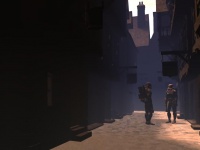 The City of Lyon
The City of Lyon
Lyon
Sister city of Tailyon. The city of Lyon was originally established as a blue collar, or working class, town of gathers whom worked to provide the planet with countless resources to stimulate their advancement and economies. Amongst their duties, the city clear cuts for lumber, mines ore and collects valuable minerals and gems from the surrounding area. These items are then packaged, raw, and shipped to varying places that provide a meager income for the denizens of the city.
However, a percentage of the resources are saved and shipped to nearby center of civilization known as Tailyon. Without these goods, or Lyon’s willingness to see their sister city succeed, the town could not pride itself as a reborn Lyon where fine arts and crafting prosper despite their lack of obvious means to collect resources. Due to this, the city of Lyon is rewarded with the ability to utilize the artisans of Tailyon to produce great works of art and maintain a prestigious, yet simple landscape.
The cityscape is dominated by collections of industrial parks infused with a suburban atmosphere. The pockets of civilization are utilitarian; meaning the city falls into a grid of streets and is simplistic in nature. The domiciles are simple hovels in an assortment of colors, but restricted models. Each building contains two rooms, a common area, kitchen and a refresher station. It is designed for the working class, short on luxury and lavish detail. The city has instead focused on advancing its overall aesthetic nature by creating parks and public centers that can be utilized by all occupants of Lyon.
 The City of Tailyon
The City of Tailyon
Tailyon
Sister city of Lyon. The city of Tailyon was created to counter the working class nature of Lyon; presenting future generations an opportunity to advance beyond their mines and forests. It has become commonly referred as the City of Artisans due to the high populace of scholars, artisans and crafters. Chief export of the city is its education, crafted goods and art that is featured in every prevalent port, or city, upon Judecca.
The city itself is striking beautiful, crafted of buildings in a thousand different shapes and designs; though, each building shares a soft, gentle hue and soft, smooth outer walls that give the city a tranquil nature. Amongst travelers of the Cocytus system, Tailyon has been called the Jewel of the Middle Core and, because of this, has an increased amount of tourists and devotees of the arts regularly appear to leave their mark on the growing city.
The city, however, is dependent on the continued alliance with the city of Lyon. Tailyon, whom was founded by the children of Lyon, lacks proper location to provide itself much beyond fresh water. Without the continued food supply, resources and general amount of trade between the two cities, Tailyon would fall into oblivion.

Rousae
The City of Mystics. The exact events and details of the secluded city are unknown to outsiders, though many speculate it is home to the planet’s greatest center of sorcerers, clerics and necromancers. This hypothesis is based on records of common individuals seeking out the city - drawn by an unknown force - before returning to the world as a skilled adepts of dark arts.
It is rumored that the city is based about a great Academy of the planet’s most skilled Masters. The Academy is a giant spire with four attached towers; each attached and representing a known magical art of Judecca. The center spire, however, is of the greatest import as it is the only complete catalogue of Judecca’s advancement, knowledge and experience with the mystical nature of the Cocytus System. It is known, by its students, as the Great Library. However, each tower plays host to the Academy’s occupants and is the primary facility for mentorship within the respective skill set.
The buildings are said to be archaic, the first of all permanent buildings to be erected upon the planet’s surface. The material used to craft them is unknown, as was the process that allowed the massive blocks of ore to be interlocked into one another. At first sight, the building appears to be made of stone; however, after careful study and observation it is instead suggested that the entire structure was refined ore. It is believed to be a gift from the gods of Judecca unto their worthy disciples.
 The Missing City
The Missing City
Missing City
Once stood the proud city of Carsa, before the Yuuzhan Vong attempted to conquer the planet. The first, and most prominent, of cities to fall was the sprawling spaceport of Judecca. However, once the Yuuzhan Vong were forced to retreat the city was reclaimed; however, none could claim that it still held its previous splendor or exotic nature. Forgoing the attempt to repopulate the city and reconstruct it, the Emperor ordered it remain as a permanent scar of the planet’s failure to uproot an emery force. Out of respect, and reverence, the inhabitants of the planet avoid the ruins of the once mighty city.
Seizing this advantage, the Emperor - under the cover of night - brought in advanced engineering teams from the Core worlds to produce massive tunnels and bunkers under the surface of the Missing City. These facilities were constructed with massive half-circle structures, which were bolted together and caulked to prevent moisture from squeezing through. Additionally, a series of elevators and stairways were crafted to allow for ease of movement for the occupants of these underground facilities.
This underground labyrinth of networks is utilized for the developmental growth of Clan Scholae Palatinae. Countless valuables are crafted for the prosperity of the Royal Clan. Chief amongst those resources is a Storm Trooper training facility, an assembly/production line to craft armor and personal weapons, and Sith alchemy labs that produce items such as synthetic crystals.
To hide all of this away from the denizens of the Cocytus System, the ruins were organized to create an endless labyrinth atop the surface of the facilities. This hid the entrances, making it virtually impossible to stumble across one of the eight entrances or countless quick-exit shafts. To heighten suspicion of the land, and further detour individuals, the bi-product of the facilities underneath - steam - is vented into the ruins to provide an eerie layer of unnatural, hot fog. Combined with the unknown, and unexpected, sounds produced below, it is said the land is haunted and forever tainted by the presence of the Yuuzhan Vong.
Notable Landmarks
 The Black Road
The Black Road
The Black Road
More than an expression based on the dark myths and tragedies that occur on the path. The road between the capitol city of Ohmen and the former spaceport of Carsa - now known as the Missing City - was paved with deep ore that once surrounded the Missing City. The rock, displaced as engineers cleared land, was utilized to pave the path.
The long, winding road is composed of blocks that measure twelve by twelve. And, when the sun is high, the rock shines with a luster unbecoming of its flat black hue when in hand - giving an appearance the rock is aglow with power. The advantage of this effect is that when the sun sets the stones give a gentle, dark light that, seemingly, illuminates the crossroad.
Beyond its supernatural powers and cryptic nature, the path is cursed by the inhabitants of the planet since the Yuuzhan Vong eliminated the city of Carsa. It is believed the rock is unnatural and the gods have deemed it the path in which the dead must cross as they leave for the afterlife. This is further emboldened by the coincidence that individuals - whom are unaffiliated with Scholae Palatinae - disappear and are never heard from again once they reach the perimeter of the Missing City.
 The Twin Towers
The Twin Towers
Twin Towers
Where the mountains divide and a fierce, narrow canyon splits through the crust of Judecca rest the Twin Towers. Standing on either side of the canyon, two imposing towers of identical craft and make oppose one another. However, one detail contrasts between the structures: color. One stands in stark, white stone; its counterpart in dark, black granite.
The history of the towers is integral in understanding their significance. When war and strife were still prevalent on the planet’s surface, two brothers entered into a blood feud. The feud began over a woman, but escalated when the brothers - whom were fighting for her love - accidentally landed a mortal blow on the lady. Her dying words cursed them both: “One to serve light, one to serve darkness - an eternity of war.”
The towers mirror one another, as each brother duplicated the other to assure an advantage was not found. Both towers have a massive base, hundreds of feet in diameter and circular in nature. Each is surrounded by an ancient grove, serving as a barrier from forthcoming armies - slowing their steps and making them circumnavigate to reach the fortified structure. Concerning the items, of note, that were duplicated: a massive portal to provide entrance, a keep built outward from the main spire, recessed structure that provides a ring about the middle of the tower to allow soldiers to defend from a higher vantage point.
It is believed the towers are now under the ownership of a great mystic of Scholae Palatinae, but these rumors can neither be confirmed nor denied.
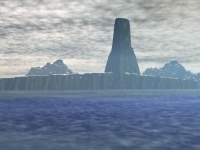 Dragon's Point
Dragon's Point
Dragon’s Point
The coast of the continent of Dragan has a run of high walls, believed to once be mountains, that have since fallen into the sea. Upon this expanse of rock resides a massive face of stone that protrudes - extending over the sea - creating a giant platform. From above the point appears to be a giant tooth, much like that of a dragon’s.
An ancient myth exists amongst the Syrei that in times long forgotten that Dragon Knights existed to serve the land and protect the sovereignty of a fabled kingdom. As the legend states, the riders of old would come to the platform and be adorned with ornate, mystical armor that would protect them during their tenure of service; once a Knight had properly been fitted and honored it is said his mount would land upon the stone and allow the rider upon his back.
To further this fairy tale, deep furrows in the stone are accredited to the talons of massive beasts - presumed dragons - whom were said to use the point. However, scientists believe that erosion is a more probable cause for weathering. Lastly, the vantage point allows a single person to gaze off into the ocean and setting sun, creating a lasting horizon that has been labeled ‘majestic’ by nearby inhabitants.
 The Ghostly Citadel
The Ghostly Citadel
Ghostly Citadel
Once a stronghold of great renown, the formerly known Jade Fortress stands as a ruined catacomb and testament of the Yuuzhan Vong’s ability to lay siege to the strongest of citadels in the galaxy. Now, the abandoned structure lies in ruin - the fallen stone serving as a graveyard for the ten thousand warriors laid to waste in its destruction.
Before its early demise, the fortress was erected in honor of Consul Emeritus Dakari, whom brought the Clan into a second Golden Age. The defensive form was a maze of high walls and checkpoints, forcing enemies to constrict their numbers and come across a series of chokepoints that could level most armies. In these checkpoints, turrets were automated to cut down enemies from varying angles of fire - recycling off of alternating energy sources to stay constant and fresh.
The last line of defense was a great pit that led to an angled - some seventy degrees - wall. The obstruction forced aggressors to focus on their footing, preventing them from appropriately concentrating on incoming blaster bolts and crude, primitive defensive stalwarts. The only way to make haste past this defensive obstruction is a section of the fortification that falls away to permit entrance.
It is believed the defense of the Citadel was compromised by a Vong agent whom was masquerading as a human. Research and review of technical data shows that the repeating canons in the maze were deactivated before explosions erupted from the inside of the fortress to allow the Vong to access the inner circle of defense.
The remaining defensive walls and sub-sections still stand, but recovery crews reported that a menacing sense of evil permeated the structure. One documented: “The citadel felt haunted, as if the souls of the betrayed soldiers still sought purchase on this world for vengeance.” While the scenario was tragic, efforts remain to recover the lost valuables saved in the vault deep below the debris of the fallen fortress.
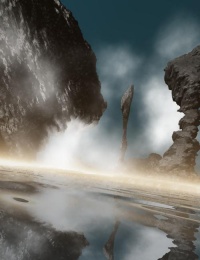 The Lake of Shadows
The Lake of Shadows
Lake of Shadows
Eerily calm, without ripples and stained with the stigma of death and the emotions associated with those tragic deaths: fear, anger, hate, jealousy. The small, unassuming lake became a location of infamy when a war between rival Clans resulted in guerilla tactics that resulted in the murder of unarmed children. The deaths of these individuals - their innocent blood - polluted the lake and made it undrinkable.
The previous life in the lake died - floating to the top. The life surrounding the lake - flora and fauna - retreated from its edges as the water was no longer bountiful. And the deaths of several individuals whom drank the water reinforced the belief it was cursed and full of dark power. These suspicions, because they had gone previously unproved, were confirmed by the members of the Royal Clan whom brought test samples to a resident alchemist, and Sith Master, of the Clan.
It was during a routine, follow-up expedition that the lake received its name, though. A member of the Clan saw the fleeting images, or force signatures, of those whom had died by the lake’s hand. These dull replications of full-grown individuals are a mock of the actual individual… fleeting… like that of a person.
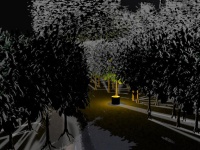 The Black Jungle
The Black Jungle
Black Jungles
A vast jungle, deep foliage layered and spread for miles, consumes the basin of a valley between two mixed climates. It is unnaturally hot, the humidity required to substantiate the necessary growth and foliage - at its high level of density - soaks into every fiber of the valley basin. Due to this condition, growth has multiplied and the vines have interwoven and created multiple layers of canopy that tower countless stories into the sky.
In the outer ring of growth, wildlife and underbrush run rampant; vast amounts of unknown species circling the fringe between jungle life and life beyond. This ring is the most active of the three circles - rife with animal activity. The next ring, or middle ring, begins to darken and underbrush clears away as the canopies grow higher and light permeation grows weaker. Larger animals circulate in this sanctum, yet they - at all costs - avoid the inner sanctum of the jungle.
The last circle, or inner ring, is clear of ground brush, but the canopy allows for no light to pass to the ground floor. Many variations of insects and reptiles call this area home; however, it is surmised that a larger predator, or pack of predators, call this inner sanctum home. While dens of these unknown animals were found during the primary expedition, they had been long abandoned and lacked enough clues to positively identify the animals.
 The Lonely Moors
The Lonely Moors
The Lonely Moors
A vast expanse of open land, which is poorly drained, is dotted with heath and pea bogs upon an elevated surface. The defining feature of the land is its wide band of existence and the layer of fog that hangs - thickly - twenty feet above the surface.
The effect of the fog is that sunlight cannot definitively punch through the layer laying upon the bog. Thus, if a traveler gets turned around or loses their sense of direction they cannot rely on using the sky to navigate. Due to this anomaly when travelers become lost, or disoriented, it has become known as the Lonely Moors.
Another distinguishing point of interest is that travelers report that they have seen lanterns, or campfires, of other wayward travelers in the distance. Yet, when they reach the point where they believed the source of light to becoming from it was nonexistent. This illusion, assumed to be heat anomalies, has become labeled with trepidation by the inhabitants of Judecca.
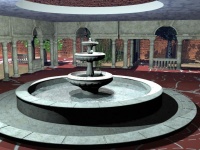 The Meditation Shrine
The Meditation Shrine
Meditation Shrine
Resting in the mountain near the Royal Palace, a small, isolated structure - approximately three miles from the Clan Headquarters - is host to Scholae Palatinae’s Meditation Shrine.
The alcove features a small garden with multiple fountains, five rooms with excellent sound isolation and a thin, stone tower with a flat roof which is only accessible by a long, narrow stair case that spirals around the tower. The location provides multiple points where a single individual may meditate in complete solitude.
The members of the Clan are known to visit this place; seeking peace and silence. Though each prefers some part of the shrine more than another, everyone is in agreement that the shrine provides clarity of thought and control of emotions.
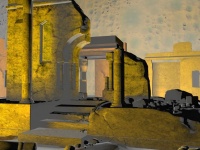 The Abandoned Temple
The Abandoned Temple
Abandoned Temple
Deep in the southern hemisphere of Judecca resides a temple hidden beneath the surface of the planet. The entrance is hidden within the Force, a secret known only by the Inner Order of Scholae Palatinae, the Sons and Daughters of Palpatine and those whom bear the name Aquillarum. The Force illusion covers a cut of stone - no larger than a doorway - that leads to the bowels of Judecca.
Accessed by a long stairway that progresses downward into the bedrock, the path bends and winds as the passage deepens. The true entrance - or access - is marked by a single, smooth black monolith with no inscriptions on it. It is said the artifact safeguards a deep, powerful source of unknown power.
Discovered during the claiming of the Cocytus System by Consul Emeritus Cuchulain Darkblade Palpatine. It is said his actions, initially, were unconsciously guided by the strange powers buried beneath the monolith’s tomb. However, this complex was originally uncovered by another - Kedeht - whom was seeking for a means to destroy the Brotherhood. His triumph was short lived though - he was killed by the members of the Aquillarum family and their allies. After their triumph, the Aquillarums sealed the temple and entrusted Scholae Palatinae with guarding it.
The members now maintain a vigilant watch over it, guarding its secret from anyone who might seek to uncover it - including those of the Royal Clan.
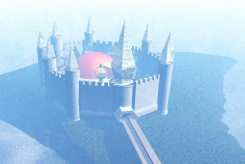 The Imperial Palace
The Imperial Palace
Imperial Palace
The Imperial Palace is the hub of Clan Scholae Palatinae in the Coccytus system and the seat of the Consul's power on Judecca.
It is set in the middle of Ohmen, the capitol city of Judecca. Created on the orders of newly annointed Thran Occasus, it took precisely 374 days to build, due to various delays and acts of sabotage. The old palace, built by the Syrei where the Emperors formerly held court was utterly demolished, though rumours circulate that the catacombs beneath still survive. The new Palace walls and turrets are made of a white marble, whilst the dome containing the Throne room is made of burnished gold. Many of the towers contain departments that are vital to running the planet and the system, including Trade and Transport, Agriculture, and the Justice and Security department.
The Palace serves as a sanctuary, a haven for the loyal Dark Jedi of the Royal Clan, where they can rest and enjoy the many pleasures that are contained within it's walls. Pleasures that stretch from fine restaurants to a small arena, the building lives up to it's nickname of 'Pleasure Palace'.
Outlook
Political
The political landscape was non-existent in the first million years of evolution upon the surface of Imperius One. However, as sentient life evolved, so did the manner in which the exercised diplomacy.
Before the reign of Clan Scholae Palatiane, prominent Warlords of several factions continually fought in search of great conquests that would expand their borders and profits. The army - composed of both male and females - was the base of operations and created nomadic tribes as the centers of populace would trail the Army to ensure protection and safeguarding. This rising, and declining, of tribes was in a continuous cycle through several eras.
The Brotherhood then began its tactical strikes against the rival Clans, and their leaders, as it sought to quell the planet for their own ends. The grand army of Scholae Palatinae swept through the planet and consolidated the Syrei - sentient beings of Judecca - into four primary Clans. To each of these Clans was a single leader, a King, appointed as representatives under the newly appointed Emperor of the Cocytus system. Thus, the feudal system - under a monarchy - was established within the System.
Each continent is ruled by a King, or Queen, but does not retain is sovereignty should a high ranking official of the Royal Clan demand their loyalty or service. However, these officials are tasked with the day-to-day political issues of their respective lands. This includes - but is not limited to - maintenance of the militia, organization of political assembly, daily operations. And, these rulers are expected to maintain the feudal system with countless members of nobility at their aide to divide the lands and manage them accordingly.
In addition to the daily grind associated with the political positions of the planet. A monthly assembly is conducted under the supervision of the King of Kings, bringing all the prominent leaders together to debate important topics, or issues, of concern. These proceedings, however, are done under the strict supervision of both the Consul and a resident Elder to ensure the minds of the Kings, or Queens, are manipulated to best serve the dark desires of the Brotherhood Clan.
Additionally, the Proconsul, or Grand Marshal, has the ability and resources to induct martial law should the current regime break down and require drastic measures.
Military
The warring Clans may have been quelled, but the culture is still geared towards militarization and the soldiers are formidable warriors in their own right. Their training, while rudimentary compared to galactic standards, is emboldened by their beliefs in religion and zealous nature. Each continent maintains its own army, which is the pseudo-law enforcement of monarchy upon the planet’s surface. These soldiers may be mobilized outside of the system; however, they are primarily held in reserve for planetary defense under the scrutiny of the Grand Marshal.
The true military might of Judecca is held by Clan Scholae Palatinae’s Proconsul as he is the acting liege lord of the Clan’s vast Legions, Fighter Corps and Fleet. Under his direct supervision are over seventeen thousand warriors, two hundred pilots and a mess of capital ships of varying ability and firepower.
The Legions of Scholae Palatiane number seventeen, but to defuse the base of power the Grand Marshal has set two Regiments upon the surface of Antenora and Ptolomea. However, this leaves him with two Regiments on Judecca, as well as the 17th Legion: The Emperor’s Children. These are under the control of the Clan’s Imperial Knights, whom serve the Grand Marshal and Emperor with unquestioned loyalty. The soldiers are standards Storm Troopers, whom were given to the Clan as a gift from the Reborn Emperor, but their commanding officers have been recruited and collected from across the galaxy to give them the sharpest tactical advantages.
Combined with the capabilities of the space forces, Scholae Palatinae is firmly established as a military power in the Cocytus System - using Judecca as their foothold.
See Also